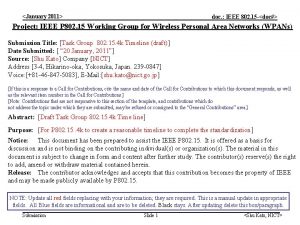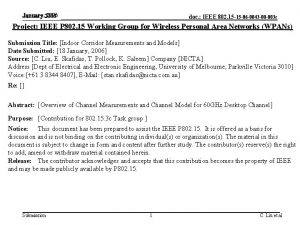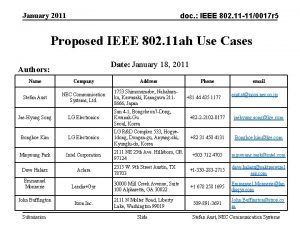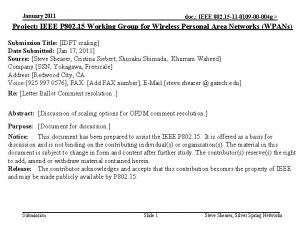January 2011 doc IEEE 802 11 110023 r








- Slides: 8

January 2011 doc. : IEEE 802. 11 -11/0023 r 0 Use Case Scenario for TGai Date: YYYY-MM-DD Authors: Name Affiliations Address Phone email Hitoshi MORIOKA ROOT INC. 2 -14 -38 Tenjin, Chuo-ku, Fukuoka 810 -0001 JAPAN +81 -92 -7717630 hmorioka@root-hq. com Hiroshi MANO ROOT INC. 2 -14 -38 Tenjin, Chuo-ku, Fukuoka 810 -0001 JAPAN +81 -3 -57197630 hmano@root-hq. com Hiroki NAKANO Trans New Technology 2 -14 -38 Tenjin, Chuo-ku, Fukuoka 810 -0001 JAPAN +81 -771 -7630 cas@trans-nt. com Submission Slide 1 Hitoshi MORIOKA, ROOT INC.

January 2011 doc. : IEEE 802. 11 -11/0023 r 0 Abstract This presentation shows an expected use case scenario for TGai. Submission Slide 2 Hitoshi MORIOKA, ROOT INC.

January 2011 doc. : IEEE 802. 11 -11/0023 r 0 Expected User • • • Hiroshi is a businessperson living in Japan. He uses e-mail, Twitter and many other internet services with his smart phone supporting WLAN. He want to update his e-mail, Twitter timeline and flight information as possible as often. He prefers to access to the Internet by WLAN rather than 3 G because of cost, speed and battery life. He usually commutes to work by rapid train which passes several stations. Submission Slide 3 Hitoshi MORIOKA, ROOT INC.

January 2011 doc. : IEEE 802. 11 -11/0023 r 0 Current IEEE 802. 11: Commute 1 • • He updates information in his home by his own private AP with IEEE 802. 11 i before departing his home. He walks to the station. There are several APs along the street. Some of them are operated by an commercial ISP (ISP-A) and he has an account to access them. When he walk through the AP cover area, his smart phone automatically trys to connect to the Internet by IEEE 802. 11 i and updates information. But it often fails to connect because of latency of connection. (authentication, key exchange, upper layer setup…) He departs the AP cover area before it complete connection. Or he must stop to wait until connection and communication completes. He arrives at the station. The station is very crowded by passengers. Here are some APs which are operated by ISP-B and available for roaming to ISP-A. His smart phone automatically trys to connect to the AP with the account of ISP-A. But it cannot connect in most cases. Because many passengers have smart phones and they also try to connect. It causes many collisions and air time shortage. At this time, he cannot update any information after departing his home. Submission Slide 4 Hitoshi MORIOKA, ROOT INC.

January 2011 doc. : IEEE 802. 11 -11/0023 r 0 Current IEEE 802. 11: Commute 2 • • He gets on a rapid train. The train passes through some stations. ISP-B operates APs at all stations along the route. When the train is passing a station, his smart phone trys to connect to a AP at the station. But it fails to connect because of latency for connection. The train passes the station before the smart phone completes connection. He gets off the train and arrives the station. His smart phone cannot connect by the same reason at the departing station. He walks to his office. There are some APs operated by ISP-C doesn’t have roaming agreement with ISP-A. So he also has an account for ISP-C. But his smart phone often fails to connect by the same reason as on the way to the departing station. Finally, despite he has some valid account, he cannot update information on his commute way in most cases until he arrives his office. Submission Slide 5 Hitoshi MORIOKA, ROOT INC.

January 2011 doc. : IEEE 802. 11 -11/0023 r 0 TGai: Commute 1 • • He updates information in his home by his own private AP with TGai before departing his home. He walks to the station. There are several APs along the street. Some of them are operated by an commercial ISP (ISP-A) and he has an account to access them. When he walk through the AP cover area, his smart phone automatically trys to connect to the Internet by TGai and updates information. It can smoothly connect and update information because of short latency for connection by TGai. He arrives at the station. The station is very crowded by passengers. Here are some APs which are operated by ISP-B and available for roaming to ISP-A. His smart phone automatically trys to connect to the AP with the account of ISP-A. It can smoothly connect and update information because of small air time occupancy of TGai. So he can check updated information on the train. At this time, he got the newest information. Submission Slide 6 Hitoshi MORIOKA, ROOT INC.

January 2011 doc. : IEEE 802. 11 -11/0023 r 0 TGai: Commute 2 • • He gets on a rapid train. The train passes through some stations. ISP-B operates APs at all stations along the route. When the train is passing a station, his smart phone trys to connect to a AP at the station. It can smoothly connect and update information because of short connection latency of TGai. So he can check the newest information even in the train. He gets off the train and arrives the station. His smart phone connects and updates information. He walks to his office. There are some APs operated by ISP-C doesn’t have roaming agreement with ISP-A. So he also has an account for ISP-C. His smart phone smoothly connect and update information. Finally, He is so happy because he can always update information on his way from home to the office. Submission Slide 7 Hitoshi MORIOKA, ROOT INC.

January 2011 doc. : IEEE 802. 11 -11/0023 r 0 Questions & Comments Submission Slide 8 Hitoshi MORIOKA, ROOT INC.














